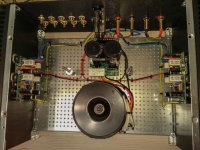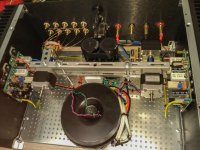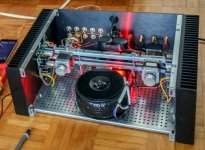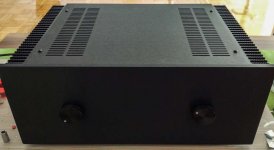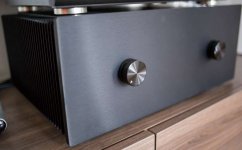The NX is already a higher gain Power Amplifier than most.
It has 2k7/5 for the upper leg and 15r for the lower leg giving a gain of 37times.
Mosy Power Ampliifirs have a gain between 20times and 30times.
Most domestic set ups have too much gain using that typical amp gain of 20 to 30 times.
Hi Andrew,
How you got the value 37.😕 if it is 2.7k and 15 R voltage gain is 180 (45 db).Or I am wrong?
joshvi
Last edited:
I wrote
If the 2k7 were a singleton, then the gain would be 181times.
the 2k7 are five in parallel. That is what is shown in the NX schematic.It has 2k7/5 for the upper leg
If the 2k7 were a singleton, then the gain would be 181times.
Last edited:
It would seem to say that most amplifiers have to much gain would be to ignore the efficiency of the speaker you are using in that equation. There would be a big difference between an 86db per watts efficiency and a 98db per watt efficiency speaker setup.
Indeed. A 98dB speaker would probably be more suited to a 10times gain Power Amplifier, or even lower.
I agree that many don't need a 500 watt amplifier to drive their speakers in a domestic environment, we're not doing PA here but at the same time I would think the S/N ratio at lower outputs of an amplifier would be a better figure to look at.
just a small update from me...
i've got the amp up and running, although i didn't resolve my issue with input dc offset, so i left out the bipolar (input) cap... so far my sources don't have a dc offset so until it's like that, no problem... output dc is in the range of few mv, no any buzz or hum, i'm pretty satisfied with that part, but i'm even more satisfied with the overall impression, the sound is great for me, also plenty of power and reserve for my visatons, just the amp i wanted to build 😉
attached a few pictures, final build is impressive, even the wife is amazed how good it looks, which is not a small achievement in diy projects, i'm sure most will agree 😀
btw, i've forseen the remote for the amp (hence the motors installation), but still no time for implementation, also the input cap is still an issue, so it's still not 100% completed, but right now i'm not bothered with any of that, important it's running... and it's running fast 🙂
i've got the amp up and running, although i didn't resolve my issue with input dc offset, so i left out the bipolar (input) cap... so far my sources don't have a dc offset so until it's like that, no problem... output dc is in the range of few mv, no any buzz or hum, i'm pretty satisfied with that part, but i'm even more satisfied with the overall impression, the sound is great for me, also plenty of power and reserve for my visatons, just the amp i wanted to build 😉
attached a few pictures, final build is impressive, even the wife is amazed how good it looks, which is not a small achievement in diy projects, i'm sure most will agree 😀
btw, i've forseen the remote for the amp (hence the motors installation), but still no time for implementation, also the input cap is still an issue, so it's still not 100% completed, but right now i'm not bothered with any of that, important it's running... and it's running fast 🙂
Attachments
Wow - that's very nice Petar - congratulations!
Very glad you like the sound - hope you get many years of enjoyment from your amp!
🙂
Very glad you like the sound - hope you get many years of enjoyment from your amp!
🙂
Just to address the gain questions/observations coming up in earlier posts:-
I generally look to provide full output swing with 1V input (0 dBV). The gain of the nx-Amp is 37x so with a little over 1V input, the amplifier output will swing to 40V peak, giving 100W RMS into 8 Ohms which was the design goal.
Same logic applies in the sx-Amp which is powered off +-20 to 22 V rails - 1 volt input or thereabouts gives full output.
Personally I would not get too hung up on this. Currently, commercial amplifier input sensitivities for full output range from about 500 mV to as high as 2V, with ~1 V appearing to be the most popular. In most cases there is plenty of gain in the preamp stages and you can always use your volume control to reduce signal levels.
If you do have very high sensitivity speakers, its probably best to go with the sx-Amp which has a gain of 14.3x. On 98 dB horns, there is no need for the 100 W of the nx-Amp.
🙂
I generally look to provide full output swing with 1V input (0 dBV). The gain of the nx-Amp is 37x so with a little over 1V input, the amplifier output will swing to 40V peak, giving 100W RMS into 8 Ohms which was the design goal.
Same logic applies in the sx-Amp which is powered off +-20 to 22 V rails - 1 volt input or thereabouts gives full output.
Personally I would not get too hung up on this. Currently, commercial amplifier input sensitivities for full output range from about 500 mV to as high as 2V, with ~1 V appearing to be the most popular. In most cases there is plenty of gain in the preamp stages and you can always use your volume control to reduce signal levels.
If you do have very high sensitivity speakers, its probably best to go with the sx-Amp which has a gain of 14.3x. On 98 dB horns, there is no need for the 100 W of the nx-Amp.
🙂
thank you, Bonsai, invested a lot of money (like never before) and time into this one, i also hope it will serve me for a long time, but considering the initial impressions i'm sure it will 😉
Hi, I have collected all parts to construct the SX version including the PCB's from Jims Audio. I hope to use some heat sinks that I already had. To enable me to do this it would beneficial for me to not connect the output devices directly to the PCB but to have them spaced away by 60 to70mm. Would this create any ill effects?
I probably will not be starting building for several months, just trying to get the best design for the parts I have.
Regards
Alan
I probably will not be starting building for several months, just trying to get the best design for the parts I have.
Regards
Alan
Alan, re your sx-Amp build - this should be ok. If you do run into any instability issues, you can add a 4.7 Ohm resistor in the base of each output transistor with the resistor located as close as possible to the transistor.
Of course, it is preferable to mount the amplifier boards as shown in the write-up, but if you cannot get the correct heatsinks then lets try it with the ones you have.
Of course, it is preferable to mount the amplifier boards as shown in the write-up, but if you cannot get the correct heatsinks then lets try it with the ones you have.
After numerous hours of playing, I just love this amp! But I have a BIG problem. Before I go and troubleshoot, I would like to hear some possibilities what could be wrong.
Today I powered up the amp and there was smoke. So I janked the plug out, waited for the smoke to clear and opened up the cover. Three of the six resistors(what I can see the left side Zobel) are nicely cooked. They now measure 3Ohm a piece instead of 10. So my guess is that they are well (over) done.
What could trigger this? And why only one side?
Help is appreciated.... I do not dare to power the amp up again.....
Kind regards,
Sjoerd.
Today I powered up the amp and there was smoke. So I janked the plug out, waited for the smoke to clear and opened up the cover. Three of the six resistors(what I can see the left side Zobel) are nicely cooked. They now measure 3Ohm a piece instead of 10. So my guess is that they are well (over) done.
What could trigger this? And why only one side?
Help is appreciated.... I do not dare to power the amp up again.....
Kind regards,
Sjoerd.
The only way the Zobel will fry like that is if you have HF in the amp.
The nx (and sx) amp will swing rail to rail at 100 kHz no problem - but if you do this you will fry the Zobel.
What are you using as a source?
The nx (and sx) amp will swing rail to rail at 100 kHz no problem - but if you do this you will fry the Zobel.
What are you using as a source?
- Home
- Amplifiers
- Solid State
- SX-Amp and NX-Amp
